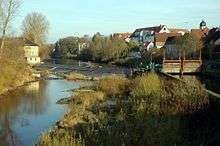Kocher
| Kocher | |
|---|---|
 A dam on the Kocher in Oedheim | |
| Basin | |
| Main source | Swabian Alb |
| Source elevation | 510 m |
| River mouth |
Neckar 49°13′22″N 9°12′7″E / 49.22278°N 9.20194°ECoordinates: 49°13′22″N 9°12′7″E / 49.22278°N 9.20194°E |
| Size | 1,800 km² |
| Country | Germany |
| Physiognomy | |
| Length | 168 km |
The ![]() Kocher is a 168 km (104 mi)-long right tributary of the Neckar in the north-eastern part of Baden-Württemberg, Germany. The name "Kocher" originates from its Celtic name "cochan" and probably means winding, meandering river. The Kocher rises in the eastern foothills of the Swabian Alb from two karst springs, the Schwarzer (black) Kocher and the Weißer (white) Kocher. The Schwarzer Kocher drains an area of approximately 1,800 km2 (690 sq mi) mostly covered by forest. Its source discharge varies between l/s and 4,000 l/s with an average of 680 l/s. The Weißer Kocher has an average discharge of 400 l/s.
Kocher is a 168 km (104 mi)-long right tributary of the Neckar in the north-eastern part of Baden-Württemberg, Germany. The name "Kocher" originates from its Celtic name "cochan" and probably means winding, meandering river. The Kocher rises in the eastern foothills of the Swabian Alb from two karst springs, the Schwarzer (black) Kocher and the Weißer (white) Kocher. The Schwarzer Kocher drains an area of approximately 1,800 km2 (690 sq mi) mostly covered by forest. Its source discharge varies between l/s and 4,000 l/s with an average of 680 l/s. The Weißer Kocher has an average discharge of 400 l/s.
Course
The Schwarzer Kocher rises south of Oberkochen. The second source, the Weißer Kocher rises west of Unterkochen from many small sources. The name Weißer Kocher comes from the white foam on the water when it quickly rushes over the stones. In contrast, the Schwarzer Kocher flows rather slowly and the covered ground gives the water a dark color. Both headwaters join in Unterkochen and flow north through the city of Aalen and Wasseralfingen until Hüttlingen, where the Kocher turns west in the direction of Abtsgmünd. Here the Lein river discharges into the Kocher. The Kocher then winds further north-west to Unterrot, where it receives the river Rot and continues to the cities Gaildorf and Schwäbisch Hall. Near Geislingen the Bühler river flows into the Kocher. In a wide curve the Kocher then turns west again, cutting into the plain of Hohenlohe and flowing through Künzelsau. It continues further to Neuenstadt am Kocher where it receives the Brettach river. Near Bad Friedrichshall the Kocher flows into the Neckar, a few Kilometers upstream from the mouth of the river Jagst, that flows more or less parallel north-east to the Kocher.

Water quality and pollution
Many industrial sites in the upper Kocher valley and poor sewage plants led to heavy pollution of the Kocher. In 1984, the Kocher was declared the most polluted river in the administrative district of Stuttgart. After only a six years remediation project, the water quality significantly improved and today the Kocher is only moderately polluted. The mostly brown color of the Kocher comes from mud in the water and does not mean bad water quality.
External links
References
- Lott, Berhard H. Der Kocher von der Quelle bis zur Mündung (German). Swiridoff Verlag, Künzelsau, 2002. ISBN 3-934350-80-1
|